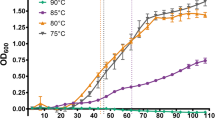Abstract
The capacity of stationary phase cultures of Schizosaccharomyces pombe to survive a heat treatment at 55°C is controlled by a circadian rhythm. In a synchronizing light-dark-cycle this rhythm shows a stable phase relationship to the onset of light. In continuous darkness it persists for several cycles without marked damping. The free-running period of about 27 h at 30°C is only slightly longer at 20°C, hence temperature-compensated. These results indicate that S. pombe is a suitable experimental organism for further research into both heat tolerance and circadian rhythms.
Similar content being viewed by others
References
Botstein D, Fink GR (1988) Yeast: an experimental organism for modern biology. Science 240:1439–1443
Bünning E (1973) The physiological clock. Springer, Berlin Heidelberg New York
Costello G, Rodgers L, Beach D (1986) Fission yeast enters the stationary phase G0 state from either mitotic G1 of G2. Curr Genet 11:119–125
Edmunds LN Jr (1988) Cellular and molecular bases of biological clocks. Models and mechanisms for circadian timekeeping. Springer, Berlin Heidelberg New York
Egel R, Kohli J, Thuriaux P, Wolf K (1980) Genetics of the fission yeast Schizosaccharomyces pombe. Ann Rev Genet 14:77–108
Hall JC, Rosbash M (1987) Genetic and molecular analysis of biological rhythms. J Biol Rhythms 2:153–178
Hutchison VH, Maness JD (1979) The role of behaviour in temperature acclimation and tolerance in ectotherms. Am Zool 19:367–384
Kappen L (1981) Ecological significance of resistance to high temperature. Encyclopedia of Plant Physiology NS 12A:439–474
Kappen L, Lösch R (1984) Diurnal patterns of heat tolerance in relation to CAM. Z Pflanzenphysiol 114:87–96
Kippert F (1987) Endocytobiotic coordination, intracellular calcium signaling, and the origin of endogenous rhythms. Ann NY Acad Sci 503:476–495
Mitchison JM (1970) Physiological and cytological methods for Schizosaccharomyces pombe. Meth Cell Physiol 4:131–165
Plesset J, Ludwig JR, Cox BS, McLaughlin CS (1987) Effect of cell cycle position on thermotolerance in Saccharomyces cerevisiae. J Bacteriol 169:779–784
Rensing L, Bos A, Kroeger S, Cornelius G (1987) Possible link between circadian rhythm and heat shock response in Neurospora crassa. Chronobiol Intern 4:543–549
Schenberg-Frascino A, Moustacchi E (1972) Lethal and mutagenic effects of elevated temperature on haploid yeast. I. Variation in sensitivity during the cell cycle. Mol Gen Genet 115:243–257
Schwemmle B, Lange OL (1959) Endogen-tagesperiodische Schwankungen der Hitzeresistenz bei Kalanchoe blossfeldiana. Planta 53:134–144
Author information
Authors and Affiliations
Rights and permissions
About this article
Cite this article
Kippert, F. Circadian control of heat tolerance in stationary phase cultures of Schizosaccharomyces pombe . Arch. Microbiol. 151, 177–179 (1989). https://doi.org/10.1007/BF00414435
Received:
Accepted:
Issue Date:
DOI: https://doi.org/10.1007/BF00414435




